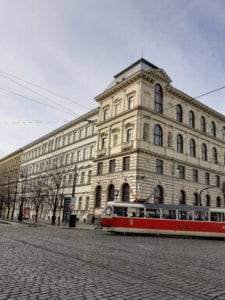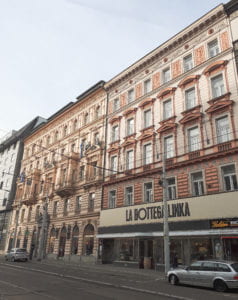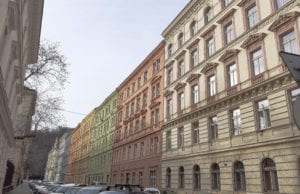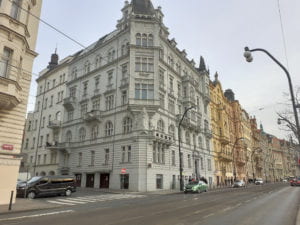Wednesday, February 26, 2020 | Written by Blanca
The saying is, “All good things come in pairs,” and blog posts about Prague are no exception to this rule! This week, I’m revisiting Prague—figuratively and literally, as I’m currently writing this while reclining on the bed of my Airbnb in the heart of downtown Prague, the second (and penultimate) destination of my spring break itinerary. I’m actually back in Prague on a solo trip for the next two days, and I couldn’t be more excited to see the city even more thoroughly and closely, but first I wanted to recap the second half of my visit last week.
The end of last week’s blog post saw us retracing our steps down Nerudova Street and back across to the Charles Bridge on Friday evening, after which we stopped for a traditional Czech dinner (or maybe quasi-traditional? consensus is lacking) of pork knuckle and returned to our Airbnb for some much-needed rest. The next morning, I headed out bright and early before the rest of my travel group, determined to hit all the spots on my map of must-see places in Prague. First up was the Jerusalem Synagogue, sometimes also referred to as the Jubilee Synagogue, a vibrant Art-Nouveau-meets-Moorish synagogue known for its richly patterned exterior and elaborately painted interior (unfortunately I wouldn’t be able to see the latter, as it was Saturday). My walk to the synagogue took me through the Old Town, which on that chilly morning seemed as if it hadn’t yet awoken from its slumber. Surprisingly, though, that seemed to make it all the more enchanting, as if I was sharing an early morning stroll with the buildings themselves.

Upon arriving at the synagogue, I was in for another surprise, this time a less pleasant one: half of the synagogue was covered in scaffolding for repairs. Building repairs seem not to be an isolated incident around this time of year, as a week later I encountered the same thing in London with the Big Ben, the entirety of which, save for its clock face, was obstructed by scaffolding. Although slightly dismayed, I must admit that the dancing patterns of the Jerusalem Synagogue were still brilliantly striking even when only half exposed.

My first destination satisfied, I was soon on my way to the next, which was admittedly less of a single location and more of a network of streets that surrounded the Old Town Square. Abandoning my trusty Google Maps in favor of serendipitous exploration, I wandered the tucked-away streets and cobbled lanes, taking note of the buildings lining the street as they shifted from exhibiting motifs of Historicism and Baroque styles to becoming increasingly Medieval closer to the Old Town Square.
A little while later, I was rejoined by my traveling companions at Paneria Paul Kaprova, the café in which I’d met up with Livia the day before, where we had a light brunch and planned out our itinerary for the rest of the day. As we had much to see, we were soon off, crossing the Vltava (this time on a bridge that was significantly less crowded than the Charles Bridge) into Prague’s Malá Strana, or the Lesser Town.
Despite its diminutive name, the Lesser Town is no less interesting and full of character than anywhere else in Prague. To illustrate this point, the first place we stopped was the Vojan Gardens (Vojanovy Sady), which we entered through an unsuspecting and rather missable set of plain wooden doors. We initially weren’t looking to enter the garden, but afterwards were grateful to have done so as it turned out to be a hidden gem, with a long, bench-lined central walkway and a pond with ducks snoozing nearby. I’m a huge fan of any feathered friend, so I was pleased to find that the ducks were in the company of pigeons (a familiar sight in Prague) and peacocks (a not-so-familiar sight in Prague), preening their feathers in the morning sun. On a side note, I was initially rather concerned for the peacocks’ wellbeing, since I’d only ever seen peacocks before in Orlando, Florida, the climate of which is starkly different from the harsh, Eastern European setting of Prague, but they seemed not to mind. In any event, the presence of peacocks contributed to the serene, enchanting air of the garden, and I could only imagine how much more idyllic it would be in the spring and summer months with the grass greener, flowers blooming, and the foliage on the blossom trees and willows much fuller. A quick Google search informed us that the secluded park originated as a monastery garden, and although it is the oldest partially preserved garden in Prague, the same tranquility seems to have remained.
The next stop after the Vojan Gardens was the John Lennon Wall, upon which I could read years upon years of scrawled messages—love notes, pleas for peace, and uplifting thoughts on humanity and the world. Deciding to leave my mark in Prague, however small, I added my name to the layers of writing, a tiny script that occupied three square inches of real estate. Given how small I felt compared to the sprawling city of Prague, this seemed especially fitting.
Our walks took us back up Nerudova Street, which during the day seemed even more steep than we’d remembered, and through the Prague Castle gates. During the day, we had an even clearer view of the city below, but deciding that we wanted an even more expansive aerial view, we continued hiking uphill to Petřín Hill. Amidst secluded rose gardens (which I’d imagine would have been magical during the summer) and the Štefánik Observatory, our view framed by tree branches (which, again, probably would’ve made the scene all the more picturesque during the greener summer months), we surveyed almost the entirety of Prague 1 and some of Prague 2. Descending Petřín Hill, we traversed winding paths, many of which were impressively cobbled, and stepped alongside streams of water, which made their way down the steep hill much more gracefully than we did.
With all this walking, we’d begun to work up an appetite, so the next order of business was to get a bite to eat. As we strolled through the neighborhoods of Malá Strana toward Café Savoy, a restaurant about which we’d heard plenty of positive recommendations, I began to see why the area is called the Baroque Heart of Prague.

And to my delight, peppered among the ornate facades of Baroque architecture were streets lined entirely with pastel buildings reminiscent of the Italianate Renaissance style that you might see in SoHo, Manhattan, albeit a bit less cast-iron and industrial and more stately and classically baroque. SoHo is one of my favorite neighborhoods in Manhattan because of this architectural style, so walking among buildings of a similar style, but which were distinctly unique in their own right, meant that I was absolutely entranced. If I hadn’t been in love with Prague already, I suspect this would’ve been the tipping point.
We found ourselves at the entrance of Café Savoy a few minutes later (and much too soon, in my opinion, as I was having the time of my life obsessively looking at buildings). The term “café” might be a bit misleading, as just like the outside of the restaurant, the interior of Café Savoy was what can only be described as positively swanky. It wasn’t hard to see why the lavish, jazz-lounge-meets-art-deco-bar-meets-First-Czechoslovakian-Republic eatery was completely packed, and their food certainly met the same standard. I personally ordered a plate of eggs benedict (can you ever go wrong with eggs benedict?), and after chowing down, we were off on our way again.

Our next stop was the Dancing House, an architectural collaboration between Frank Gehry and Croatian-Czech architect Vlado Milunić. A deconstructivist building that looks as if it’s dancing, hence its name, the Dancing House certainly stood out among its Baroque neighbors along the Vltava River. Nonetheless, it was a fascinating building, and if you’re into contemporary and modern architecture, this is definitely a building to add to your list of places to see.
The final destination of the night was Vyšehrad, a 10th-century fort on the East bank of the Vltava in Prague 2. Recommended to us by both Livia and our server in the restaurant in which we had breakfast the day before, the fort proved to be one of the highlights of my trip. Though the sun had long begun to set, we strolled through a charming village at the top of the (once again very steep) hill on which Vyšehrad is situated, which was abuzz with light and activity. The gothic Basilica of St. Peter and St. Paul, which could be seen during our travels for miles around due to its stark, dark spires and prominent location on top of a hill, had unfortunately closed to the public half an hour before our arrival, but no matter, as Vyšehrad proved to be the perfect way to end a weekend in Prague.
The sun dipped behind the hills, its dwindling golden light painting the cotton candy sky a swirl of purple and magenta and blue. As a layer of calm came upon the houses that blanketed the hills, warm glowing lights emitting intermittently from the far-away windows, I watched the twinkling of headlights wind around the banks of the Vltava and thought, for the umpteenth time that weekend, that Prague just might have been the most enchanting city I’d ever visited.
![[vysehradSunset.jpg] Watching the sunset from the battlements of Vyšehrad](https://bpb-us-e1.wpmucdn.com/sites.gatech.edu/dist/8/307/files/2020/02/vysehradSunset-300x225.jpg)
